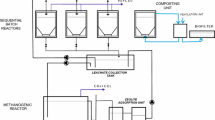Abstract
The feasibility of applying the up-flow anaerobicsludge blanket (UASB) treatment for poultry waste (faeces)water was examined. A continuous-flow UASB pilot scalereactor of 3.50 L capacity using mixed culture was operatedfor 95 days to assess the treatability of poultry waste-water and its methane production. The maximum chemicaloxygen demand (COD) removed was found to be 78% whenorganic loading rate (OLR) was 2.9 kg COD m-3 day-1 athydraulic retention times (HRT) of 13.2 hr. The averagebiogas recovery was 0.26 m3 CH4 kg COD with an averagemethane content of 57% at mean temperature of 30 °C.Data indicate more rapid methanogenesis with higher loadingrates and shorter hydraulic retention times. At feedconcentration of 4.8 kg COD m-3 day-1, anaerobic digestionwas severely retarded at all hydraulic retention timetested. This complication in the reactor operations may belinked to build-up of colloidal solids often associated withpoultry waste water and ammonia toxicity. Isolates fromgranular sludge and effluent were found to be facultativeanaerobes most of which were Pseudomonas genera.
Similar content being viewed by others
References
APHA (APHA, AWWA, LWPCT): 1995, Standard Methods for the Examination of Water and Wastewater, 18th ed., Washington D.C.
Christiansen, N., Hendriksen, H. V., Jurvinen, K. T. and Ahring, B. K.: 1995, 'Degradation of chlorinated aromatic compounds in UASB reactors', Wat. Sci. Tech. 31(1), 249–259.
Dinsdale, R. M., Hawkes, F. R. and Hawkes, D. L.: 1997, 'Comparison of mesophilic and thermophilic UASB reactors treating instant coffee production wastewater', Wat. Res. 31(1), 163–169.
Holt, J. G., Kreyg, H. R., Sneath, R. H. A., Staley, J. T. and Williams, S. T.: 1994, Bergey's Manual of Determinative Bacteriology, 9th ed., The Williams and Wilken Company, Baltimore, U.S.A.
Kispert, R. G., Sadek, S. E. and Wise, D. L.: 1975, 'An economic analysis of fuel gas production from solid waste', Resource Recov. Conserv. 1, 95–109.
Koster, W. and Lettinga, C.: 1985, 'Application of UASB process for treatment of complex wastewater at low temperatures', Biotech. Bioeng. 27, 1411–1417.
Khursheed, A., Faroogi, I. H. and Siddiqui, R. H.: 1997, 'Development of granular sludge on cane sugar mill waste treatment using a pilot scale UASB reactor', Indian J. Environ. Health 39(4), 315–325.
Missing, R. A.: 1988, 'Immobilized Cells in Anaerobic Waste Treatment', in M. Moogourg (ed.), Bioreactor Rhyzymes and Cells. Fundamentals and Application, Elsevier Applied Science, New York, pp. 311–316.
Steel, R. G. D. and Torrie, J. H.: 1960, Principles, Procedures and Statistics, New York, McGraw-Hill.
US/EPA: 1994, Poultry Processing Wastewater Treatment and Re-use, EPA-660/2-74-060.
Varel, V. H., Issacson, A. A. and Bryant, M. P.: 1977, 'Thermophilic methane production from cattle waste', Appl. Environ. Microbiol. 33(3), 298–307.
Wiegant, W. M. and Lettinga, G.: 1985, 'Thermophilic anaerobic digestion of sugar in UASB reactors', Biotech. Bioeng. 27, 1603–1607.
Author information
Authors and Affiliations
Corresponding author
Rights and permissions
About this article
Cite this article
Atuanya, E.I., Aigbirior, M. Mesophilic Biomethanation and Treatment of Poultry Waste-Water Using Pilot Scale UASB Reactor. Environ Monit Assess 77, 139–147 (2002). https://doi.org/10.1023/A:1015871601658
Issue Date:
DOI: https://doi.org/10.1023/A:1015871601658




